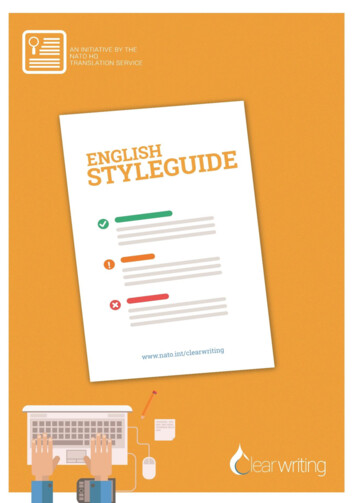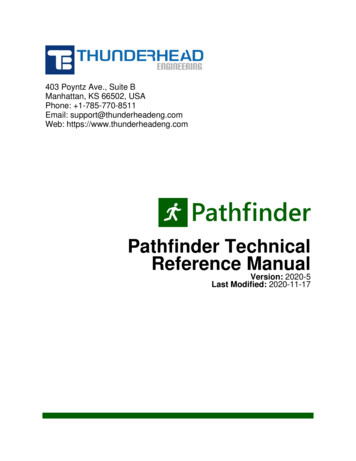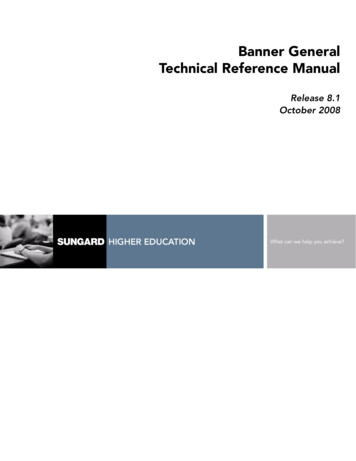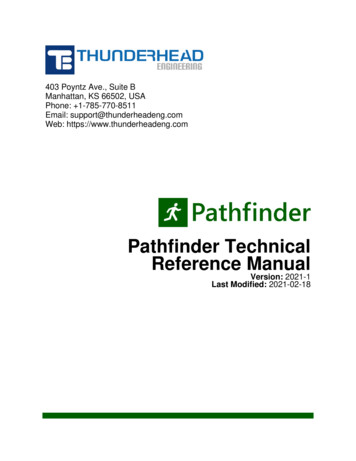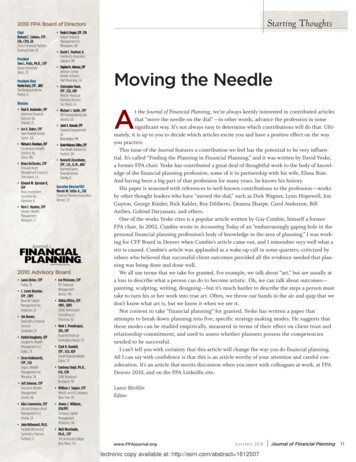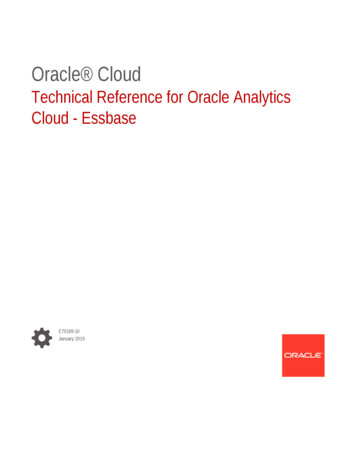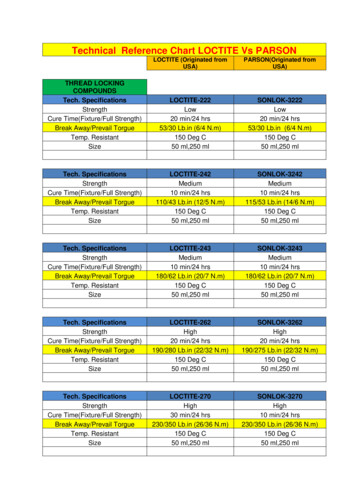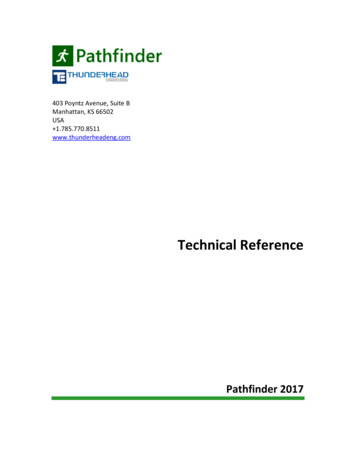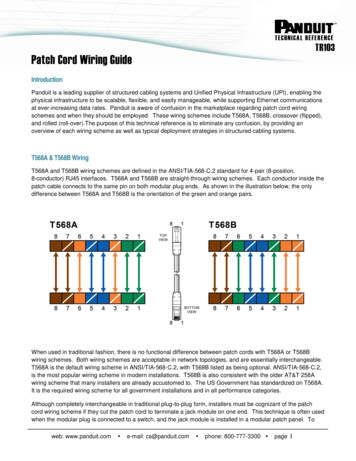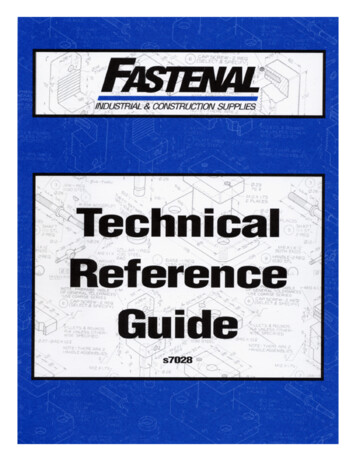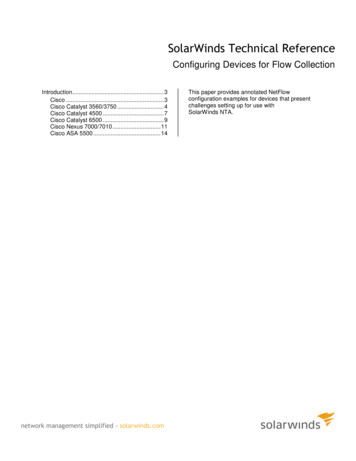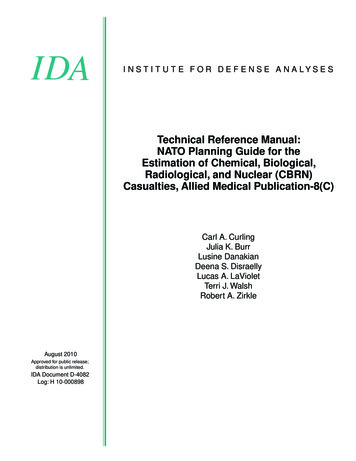
Transcription
I N S T I T U T E F O R D E F E N S E A N A LYS E STechnical Reference Manual:NATO Planning Guide for theEstimation of Chemical, Biological,Radiological, and Nuclear (CBRN)Casualties, Allied Medical Publication-8(C)Carl A. CurlingJulia K. BurrLusine DanakianDeena S. DisraellyLucas A. LaVioletTerri J. WalshRobert A. ZirkleAugust 2010Approved for public release;distribution is unlimited.IDA Document D-4082Log: H 10-000898
The Institute for Defense Analyses is a non-profit corporation that operatesthree federally funded research and development centers to provide objectiveanalyses of national security issues, particularly those requiring scientific andtechnical expertise, and conduct related research on other national challenges.About This PublicationThis work was conducted by the Institute for Defense Analyses (IDA)under contract DASW01-04-C-0003,Task CA-6-3079, “CBRN CasualtyEstimation Update of the Medical CBRN Defense Planning and ResponseProject,” for the Joint Staff, Joint Requirements Office for CBRN Defenseand the U.S. Army Office of the Surgeon General. The views, opinions, andfindings should not be construed as representing the official position ofeither the Department of Defense or the sponsoring organization.AcknowledgmentsThe authors wish to thank Ms. Mary Catherine Flythe, Dr. Jeffrey Grotte,Mr. David Hockaday, and Mr. Preston J. Lee for their contributions to themethodology documented in this Technical Reference Manual. The authorsare also grateful to Dr. John Bombardt and Dr. James Heagy for their carefulreview of this document, to Ms. Elizabeth Johnson for editing this document,and to Ms. Barbara Varvaglione for producing this document.Copyright Notice 2010 Institute for Defense Analyses4850 Mark Center Drive, Alexandria, Virginia 22311-1882 (703) 845-2000.This material may be reproduced by or for the U.S. Government pursuantto the copyright license under the clause at DFARS 252.227-7013(NOV 95).
I N S T I T U T E F O R D E F E N S E A N A LYS E SIDA Document D-4082Technical Reference Manual:NATO Planning Guide for theEstimation of Chemical, Biological,Radiological, and Nuclear (CBRN)Casualties, Allied Medical Publication-8(C)Carl A. CurlingJulia K. BurrLusine DanakianDeena S. DisraellyLucas A. LaVioletTerri J. WalshRobert A. Zirkle
Executive SummaryThe Technical Reference Manual (TRM) serves as a supplement to the NorthAtlantic Treaty Organization (NATO) Allied Medical Publication-8(C) (AMedP-8(C)),NATO Planning Guide for the Estimation of CBRN [Chemical, Biological, Radiological,and Nuclear] Casualties (referred to in this document as AMedP-8(C)). The TRMdocuments the development process, analyses, rationale, underlying data, and additionalinformation utilized to establish the environments, the human response, and the casualtyestimation methodologies which comprise the AMedP-8(C) methodology. The IDA studyteam devised a “General Equation” to calculate the environments, by converting anexposure environment to a dose, dosage, or insult and allowing for the consideration ofbreathing rates, shielding, and personal protection, among other factors. The humanresponse and casualty estimation methodologies employ profiles of injury severity overtime to describe the human response to agents and effects and then result in an estimateof the casualty’s status.AMEDP-8 (C) BackgroundAMedP-8(C) presents a methodology for estimating casualties uniquely occurring asa consequence of Chemical, Biological, Radiological and Nuclear (CBRN) attacksagainst Allied targets to support the planning processes described elsewhere in Alliedpublications. The AMedP-8(C) methodology provides the capability to estimate thenumbers of casualties over time, as well as the incidence of injury by type and severityfor a wide range of agents and effects. It can be used to estimate casualties resulting fromexposure to chemical nerve agents sarin (GB) and VX; chemical blister agent HD(distilled mustard); the biological agents causing anthrax, botulism, pneumonic plague,smallpox, and Venezuelan equine encephalitis; radiological dispersal devices; radioactivefallout from nuclear explosions; and prompt nuclear effects. As the AMedP-8(C) NATOPlanning Guide explains:These estimates assist planners, logisticians, and staff officers by allowingfor more effective quantification of contingency requirements for medicalpersonnel; medical materiel stockpiles; patient transport or evacuationcapabilities; and facilities needed for patient decontamination, triage,treatment, and supportive care. The AMedP-8(C) methodology is proposedsolely for use in deliberative or crisis action planning and does not accountfor real-time or dynamic (i.e., evolving exposure) use. Moreover, thisiii
methodology is not intended for use in deployment health surveillance orfor any post-event uses including diagnosis, medical treatment, orepidemiology.PurposeThe purpose of the Technical Reference Manual is to describe the informationpresented in or used to develop the components of the AMedP-8(C) methodology. TheTRM will: Describe the sources for, and justification of, the assumptions and recommendedvalues employed by the methodology;Identify, where appropriate, the sources for definitions and key terms used bythe methodology, or else describe where and how new definitions and termswere derived;Describe the underlying symptomatology resulting from the exposure to eachagent or effect used in the methodology;Explain how the key underlying equations and parameters employed by themethodology—such as dose, dosage, and insult ranges; dose, dosage, or insultcalculations; the radiation time-to-death equation and protracted dose factors forradiological agents; infectivity, incubation, and lethality probability functionsand parameters for biological agents; the non-contagious biological agent tables;and the contagious biological agent equations—were derived; andDescribe how the injury profiles for all chemical, radiological, and nuclearagents and effects were derived.The goal of the TRM is to make the data underlying the AMedP-8(C) methodologyand the process through which it was developed as clear as possible and to enableanalysts and modelers to understand and replicate these results and procedures.OrganizationThis Technical Reference Manual is comprised of the following chapters, whichalign closely with the chapters found in the AMedP-8(C) NATO Planning Guide.Chapter 2 corresponds to AMedP-8(C) Chapter 1, “Introduction,” and discusses thebasis for the definitions used in the NATO document as well as the assumptions andlimitations with associated rationales for the document.Chapter 3correspondstoAMedP-8(C) Chapter 2,“CalculatingDose/Dosage/Insult,” and details the values and processes utilized to calculate thedose/dosage/insult from the CBRN environment.Chapters 4 through 8 correspond to AMedP-8(C) Chapter 3, “Human ResponseEstimation,” and detail the derivations of the human response methodologies foriv
chemical nerve agents GB and VX; chemical blister agent HD; radiological agents;nuclear effects; and contagious and non-contagious biological agents, respectively.Chapter 9 corresponds to AMedP-8(C) Chapter 4, “Casualty Estimation andReporting,” and provides additional information on the casualty estimation procedures aswell as casualty estimation conditions and equations specific to particular agents andinsults.Chapter 10 provides a brief review of the study’s conclusions and presentsimplementation considerations and potential ways ahead.v
Contents1.2.3.4.Introduction .1A. Introduction .1B. Purpose .2C. Background .3D. Organization .8Applicable Definitions, Assumptions, Limitations, and Rationale of the AMedP8(C) Methodology .11A. Introduction .11B. Definitions .111. Definitions Derived from NATO References .112. Definitions Specific to AMedP-8(C) Terminology .13C. Assumptions, Limitations, and Rationale.201. General Assumptions and Limitations .202. CRN Assumptions and Limitations .223. Chemical Assumptions and Limitations.244. Radiological Assumptions and Limitations .285. Nuclear Assumptions and Limitations .306. Biological Assumptions and Limitations .32Calculation of Dose/Dosage/Insult .39A. Introduction .39B. Approach .401. Background .402. Derivation of the General Equation.41C. Agent-Specific Considerations .481. Exposure Factors .482. Shielding Factors .503. Respiratory Protection Factors .534. Dose/Dosage/Insult .54Chemical Human Response Review: Nerve Agents—Sarin and VX .61A. Introduction .61B. Background .611. Agent Physiological Effects .612. Toxicity Values .63C. Dose/Dosage Ranges .64D. Symptoms .72vii
5.6.7.8.1. Severity Levels .722. Symptom Progression and Injury Profiles.75Chemical Human Response Review: Blister Agent—Distilled Mustard .99A. Introduction .99B. Background .991. Agent Physiological Effects .992. Toxicity Values .102C. Dosage Ranges .103D. Symptoms .1101. Severity levels .1112. Symptom Progression and Injury Profiles.113Ionizing Radiation Human Response Review: Radiological Agents .121A. Introduction .121B. Background .1221. Physiological Effects .1222. Toxicity Values .125C. Dose Ranges .125D. Symptoms .1281. Injury Severity Levels .1282. Injury Profiles .1303. Radiological Injury Profiles .140Nuclear Human Response Review: Composite Nuclear Insults .143A. Introduction .143B. Background .1431. Whole-Body Radiation .1442. Blast .1443. Thermal Energy .1484. Combined Injury.150C. Dose/Insult Ranges .151D. Symptoms .1551. Injury Severity Levels .1562. Radiation, Blast, and Thermal Individual Insult Injury Profiles .1593. Composite Nuclear Injury Profiles .172Biological Agent Human Response Review: Non-Contagious and ContagiousDiseases .177A. Introduction .177B. Background .177C. Methodology Development .1771. Infectivity/Effectivity .1792. Incubation Period (Latent Period/Time to Onset) .1793. Lethality.1804. Duration of Illness .1805. Injury Profile .180viii
6. Medical Countermeasures—Vaccination/Antibiotic Prophylaxis .1817. Literature Review and Parameter Development .1818. Non-Contagious and Contagious Biological Agent Human Response .182D. Estimation of Non-Contagious Biological Agent Human Response .1831. Convolution Approach .1842. Anthrax .1883. Botulism .2034. Venezuelan Equine Encephalitis (VEE).212E. Contagious Biological Agent Human Response .2191. Derivation of the Susceptible-Exposed and infected-Infectious-RemovedProphylaxis efficacious (SEIRP) Approach .2202. SEIRP Approach .2233. Plague .2284. Smallpox .2399. Casualty Estimation .257A. Estimation of Casualties: General Considerations .2571. Recommended Time to Reach a Medical Treatment Facility .2572. Recommended Wounded in Action (WIA) Severity Level Threshold .2573. Time at Severity Level 4 (“Very Severe”) to Determine Fatalities .258B. Estimation of Casualties: Special Considerations .2591. Chemical Blister Agent (HD): Percutaneous Liquid Dose and InternalSepsis .2592. Radiological Agents: Whole-Body Radiation Dose and the Protracted DoseCalculation.2593. Radiological Agents and Radiation Insults: Whole-Body Radiation and theTime-to-Death Calculation .2634. Nuclear Blast Insults: Tertiary Blast Effects and Killed in Action (KIA) 2685. Non-Contagious Biological Agents.2716. Contagious Biological Agents .27210. Conclusions .275ix
AppendicesA. Abbreviations . A-1Abbreviations . A-1Symbols . A-6B. Glossary of Medical Terms .B-1C. References .C-1D. Illustrations. D-1Figures . D-1Tables . D-4x
1.IntroductionA. IntroductionThe North Atlan
Casualties, Allied Medical Publication-8(C) iii Executive Summary The Technical Reference Manual (TRM) . patient transport or evacuation capabilities; and facilities needed for patient decontamination, triage, treatment, and supportive care. The . AMedP-8(C) methodology is proposed
